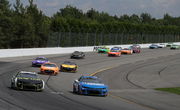
via Imago
DAYTONA, FL – FEBRUARY 18: William Byron Jr. 24 Hendrick Motorsports Axalta Chevrolet leads teammates Kyle Larson 5 Hendrick Motorsports HendrickCars.com Chevrolet, Chase Elliott 9 Hendrick Motorsports NAPA Auto Parts Chevrolet, and Alex Bowman 48 Hendrick Motorsports Ally Chevrolet during practice for the Daytona 500 on February 18, 2022 at Daytona International Speedway ion Daytona Beach, Fl. Photo by David Rosenblum/Icon Sportswire AUTO: FEB 18 NASCAR, Motorsport, USA Cup Series – DAYTONA 500 Practice Icon220218116110 | Image Credits: Imago

via Imago
DAYTONA, FL – FEBRUARY 18: William Byron Jr. 24 Hendrick Motorsports Axalta Chevrolet leads teammates Kyle Larson 5 Hendrick Motorsports HendrickCars.com Chevrolet, Chase Elliott 9 Hendrick Motorsports NAPA Auto Parts Chevrolet, and Alex Bowman 48 Hendrick Motorsports Ally Chevrolet during practice for the Daytona 500 on February 18, 2022 at Daytona International Speedway ion Daytona Beach, Fl. Photo by David Rosenblum/Icon Sportswire AUTO: FEB 18 NASCAR, Motorsport, USA Cup Series – DAYTONA 500 Practice Icon220218116110 | Image Credits: Imago
Evolution has been a constant attribute of NASCAR. Adapting to tough times through its ways has been a significant facet of the sport. One of these remedial tactics was the presence of field fillers. With time, the amount of drivers on the grid has decreased gradually. But at a point in history, the lack of numbers was offset by some peculiar means.
The history of field fillers goes back to the first automotive race in America in 1895. With the promoters inviting 80 drivers from all over the country, a successful event had been planned. However, due to unfortunate circumstances, less than a dozen racers showed up. That is when the story of field fillers began.
ADVERTISEMENT
Article continues below this ad
Field fillers’ presence since the inception of NASCAR
The historic Chicago-Herald race of 1895 had a turnout of only 11 drivers. With the event being held in November, the chilling cold prevented many from joining the race. Eventually, only six invited cars were left on the grid. Local drivers and fans contributed to filling the numbers, and the tradition has continued since then.
In 1948, when NASCAR arrived at the Daytona Beach Circuit, field fillers were motivated by the idea of participating at the start of something special. Despite being unable to finish the race, track promoters approved of this due to more drivers attracting crowds.
The practice continued to be exercised for a long time. Due to harsh financial conditions, NASCAR increased the winning purse or races and added monetary benefits for the independent teams that wanted to run the full NASCAR schedule. These changes were a lucrative attraction for the part-time owners who found glory in NASCAR’s national competitions. This move garnered some healthy numbers and fulfilled the desires of several drivers as well.
In the early 90s, NASCAR suffered from an economic stagnation. Races with a full field were slowly becoming an exception as it seemed like a dying sport to some. At that time, driver-owners like Jimmy Means took on field-fillers’ role, driving in races occasionally. To put things into perspective, in the 1992 NASCAR season, a mere 27 drivers out of the implied 43 finished the full schedule of 29 races.
With time, drivers came to terms with the problems field fillers posed, like being a hindrance to the race leader. However, for those supporting it, field filling was a means of salvaging funds from the race. In a June 2009 Cup Series race, Joe Nemechek received $64,725 for a P41 finish for a start and park attempt. On the other hand, Dexter Bean ran the entire race but earned $725 more than Nemechek.
With the 43-car field no longer in use, the instances of field fillers have reduced drastically. A significant change came in 2013 when NASCAR reduced the field size to 40. One of the main reasons was the obstruction of races they caused. 4-time championship-winning driver Jeff Gordon was a victim of it once.
ADVERTISEMENT
Article continues below this ad
Trending
Jeff Gordon’s clash with a field filler
Back in the early 2000s, NASCAR faced a lot of criticism due to adding field fillers. Inferior cars with no intention of completing the race were more obstacles for the drivers striving to win. At the 2004 Darlington 400, Jeff Gordon was involved in a wreck with part-time driver Andy Hillenburg.
In the 29th lap, Tony Stewart‘s #20 and Hillenburg’s #80 made contact which sent the latter into the inside of the track. With the cars coming at them at full speed, Jeff Gordon watched his iconic #24 hit Hillenburg in a T-Bone crash. This could have turned out to be very dangerous on another day.
ADVERTISEMENT
Article continues below this ad
Watch This Story: Denny Hamlin Blames Tony Stewart for Letting Down Slowest Kevin Harvick
With cars running 12-14 mph slower than the race leaders, field fillers could be a nuisance for the competitive drivers. However, such teams are just meant to earn some quick bucks through their participation in the race. Field fillers have been a relatively under-appreciated but ever-present part of NASCAR history.
ADVERTISEMENT
ADVERTISEMENT
ADVERTISEMENT
ADVERTISEMENT






